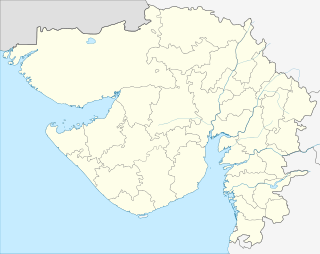Khedoi
| Khedoi | |
|---|---|
| village | |
 Khedoi Location in Gujarat, India | |
| Coordinates: 23°03′33″N 69°55′08″E / 23.059279°N 69.918955°ECoordinates: 23°03′33″N 69°55′08″E / 23.059279°N 69.918955°E | |
| Country |
|
| State | Gujarat |
| District | Kachchh |
| Panchayat | Gram Panchayat |
| Elevation | 27 m (89 ft) |
| Languages | |
| • Official | Gujarati, Hindi |
| Time zone | IST (UTC+5:30) |
| PIN | 370130 |
| Telephone code | 02836 |
| Vehicle registration | GJ-12 |
| Sex ratio | 0.894 ♂/♀ |
| Distance from Bhuj | 34 kilometres (21 mi) |
| Distance from Ahmedabad | 350 kilometres (220 mi) |
Khedoi is large village located 14 km from the town of Anjar and the taluka of Kutch district in the Indian state of Gujarat. The village is sub-divided into Nani-Khedoi and Moti-Khedoi. It has a primary health centre and a major electricity processing plant. The main occupation of the villagers is agriculture.
History
Khedoi is one of the 19 villages founded by Kutch Gurjar Kshatriyas, who first moved to Saurashtra in the early 7th century. A major group entered Kutch in the 12th century and established themselves at Dhaneti.[1] From the 12th century onwards they moved to settle themselves between Anjar and Bhuj and founded the villages of Anjar, Sinugra, Khambhra, Nagalpar, Khedoi, Madhapar, Hajapar, Kukma, Galpadar, Reha, Vidi, Ratnal, Jambudi, Devaliya, Lovaria, Nagor, Chandiya, Meghpar and Kumbharia.[2] [3][4][5]
All the old houses, temples, entrance gates and chabutro, were erected by this Kshatriya community in its heyday in the decades of 1890-1900. However, the majority of old Kshatriyas houses with their unique architect were destroyed in the earthquake of 26 January 2001.
People from Khedoi
Devji Gova Rathod of Khedoi was assistant gaidher(Gaidhar held an important place in king's court and were looked upon with respect. Gaidhar were appointed by kings, upon their skills and also loyalty. Gaidhar were persons of high integrity as they used to make the blue-print of fort and whole forts were erected under his supervision and guidance. The kings used to trust them and they had the power and authority to hire manual laborers and skilled masons for such construction works.) was from Rathod Dynasty when Jairam Ruda Gajdhar Rathor of Anjar was head gaidher during the reign of Pragmalji II of Cutch State, when Prag Mahal was built. His brother, Kanji Gova Rathor was gaidher of Kothara Darbar to Gagubha Jadeja and Abdasa-ni-Panchtirthi and other palaces built by Darbar. Another brother, Ruda Gova Rathor, was gaidher to Kaira Darbar during 1880-1895 and all buildings by Kaira Darbar were done by him[6]
Many of the Kutch Gurjar Kshatriyas were big railway contractors in the early days of railway construction by the British between 1860 and 1940.[7][8][9] Gangji Narayan of Khedoi along with Manji Dahya Vegad and Lakhu Devji Vegad of Anjar, built between 1887 and 1912 the famous Pamban Bridge and railway tracks to Rameshwaram and all of them together also built the famous seven-domed temple of Neel-Mandir at Rameshwaram, between 1899 and 1905, while they were working for Pamban Bridge[10][7]
Shivjee Jairam Rathod of Khedoi was among one of the many Kutch Gurjar Kshatriyas community pioneers who founded the colliery at Tisra in the Jharia coalfields belt[11]
Kanji Morarji Rathor of Khedoi, was industrialist, who is noted for having founded the first steel plant of Chhattisgarh in year 1960 at Raipur.
Present status
The Darbar, Jadeja, Rabari, Ahirs, Patels and, goswami dominate the village population, whereas the Kutch Gurjar Kshatriyas community who founded the village in 1450 AD are very few.
Temples
There are temples of Momay Ma, Champal Ma, Amba Ma, Shiv Mandir, Thakor Mandir and Kuldevi. Temples of many clans of these Kutch Gurjar Kshatriya community are also in this village.
Economy
The village of Khedoi now houses a well-known and prominent sector of manufacturing industry. The factory of Man Industries Limited, manufacturing steel pipes, is located on the outskirts of the village. The economy of the village depends heavily on farming. The soil surrounding the village is fertile and has farms growing mango, guava, pomegranate and other fruits and vegetable.
References
- ↑ Gurjar Kshatriyas, also known as Gajdhar, came to Kutch from Rajasthan. They are skilled in building construction. They first established themselves at Dhaneti and were granted 18 villages by the rulers of Kutch. They are famous designers and developers of buildings and bridges. Waghelas, Rathod, Chauhan, Parmar, Khodiyar, Padiyar, Sawana and Varu are the main sub classes of Gurjar Kshatriya.
- ↑ 18 Villages founded by Kutch Gurjar Kshatriyas
- ↑ One of the 18 of the ‘gams’ or Kshatriyas villages scattered in Anjar and Mundra Talukas, has now nothing to show that it was once the home to some of Kutch’s finest artisans.
- ↑ Details of artisan quality of Gajdhar
- ↑ Gajdhar of Kutch
- ↑ Nanji Bapa ni Nondh pothi complied by Dharshi Tank (Tatanagar), published 1999 at Baroda. page:5
- 1 2 Shree Kutch Gurjar Kshatriya Samaj : A brief history: by Raja Pawan Jethwa. (2007) Calcutta.
- ↑ Nanji Bapa ni Nondh pothi, published 1999 at Baroda, page 86
- ↑ Ratna Bhagat ni chopdi : 1930
- ↑ Nanji Bapa ni Nondh-pothi, 1999 , Vadodara, page 29.
- ↑ Natwarlal Devram Jethwa, Diary of Golden Days at Jharia in decade of 1910. - A Memoir & History of Gurjar Kashtriya Samaj of Kutch in Coalfields of Jharia, 1998